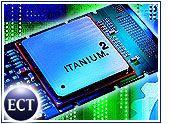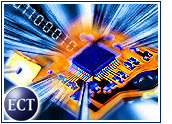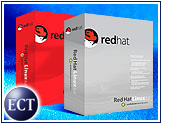
Intel could make a long-term splash in the server market with its new Itanium 2 processor, but first it must make its case to enterprise technology buyers.
Besides speedier performance, Intel officials contend that use of the processor could result in significant cost savings. According to Michael Graf, product manager of the Itanium line, the chip will enable companies to custom-configure server setups for their specific needs, and will give them more freedom when it comes time to upgrade or revise their technology.
“We believe this is going to appeal to IT managers who have been restricted by proprietary considerations on the server side,” Graf told the E-Commerce Times.
New and Improved
Introduced earlier this year and geared toward high-end processing needs, Itanium 2 is the latest incarnation of Intel’s server chip, which first entered the market in 2001. According to Intel, the latest version increases performance over the original by between 50 and 100 percent.
Itanium 2 is available at speeds of 1 GHz or 900 MHz, and it can transmit data at rates of up to 6.4 gigabytes per second. Graf said refinements over the next two years are expected to further enhance the chip’s performance while keeping it plug-in compatible for current users who wish to upgrade later.
But those who control corporate IT purse strings are unlikely to loosen them solely on the basis of newer, speedier technology. Indeed, analysts at Gartner contend that Itanium 2 faces an uphill battle on a number of fronts.
Is Speed Enough?
The first challenge facing Intel is the slowness of original equipment manufacturers (OEMs) to incorporate the processor. For instance, Gartner principal analyst Jeffrey Hewitt pointed to Dell’s announcement that it will not release a server equipped with the Itanium 2 CPU in the near future.
On top of this, Hewitt said, clear advantages of the processor have not yet been articulated to most potential customers.
“Without that, there will not be a volume play for this particular chip,” he told the E-Commerce Times. “It will take more than just a promised speed advantage to get real traction in the market for Itanium.”
No Graphics Yet
Another sticking point, according to Gartner principal analyst Pia Rieppo, is that the technology is not very useful for some common workstation applications, mainly because no Intel chipset currently supports graphics in conjunction with Itanium 2.
“What this means is that use of Itanium will be limited to computation tasks that don’t require graphics output or interactivity via a monitor,” Rieppo told the E-Commerce Times. “The Itanium 1 workstations sold in very limited numbers, but all of them were basically used in clusters for computational tasks in research.”
Picking Up Steam
Despite these hurdles, Intel’s Graf projected that Itanium 2 will be included in products sold by at least 20 OEMs by the end of 2003. He said the processor is likely to attract users not only in scientific supercomputing research settings, but also within industries that have computation-intensive design needs, such as aircraft and auto manufacturing.
Graf also said the processor should meet the needs of a number of enterprises with deep database requirements that want to access and mine data more intelligently. He added that it could help e-commerce firms, which must handle high volumes of transactions quickly but with dense encryption requirements.
While the jury remains out on the overall prognosis for the chip, IDC research director Steve Josselyn said the most likely scenario is that Itanium 2 will gain wide acceptance, but not until 2004 or 2005.
Wait and See
When widespread adoption does occur, Josselyn told the E-Commerce Times, Itanium 2 could generate about $500 million in annual revenue for Intel. He noted that such an outcome is partly contingent on 64-bit Windows operating environments reaching the mainstream in enterprises.
Even though the processor is likely to have benefits right out of the gate for computation-heavy industries like scientific research, Josselyn said most enterprises will take a wait-and-see approach for the time being.
“Companies don’t add on new technology just for the sake of getting something new,” he noted. “They need to see the benefits of it. The bleeding-edge [technology] companies are going to be the earliest adopters, but the mainstream companies are going to sit back and see what happens.”













































Social Media
See all Social Media